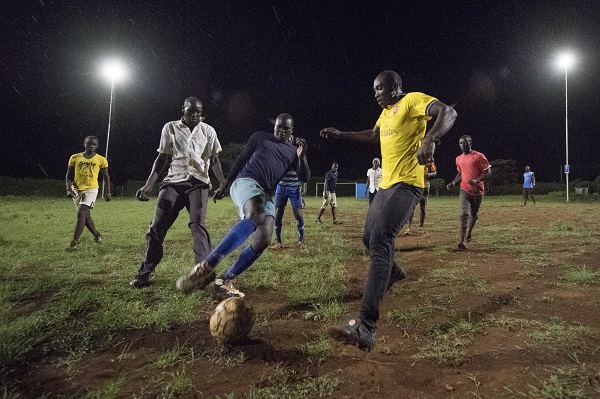 |
|
Philips Lighting announces a Solar Soccer match at its Community Light Center outside Nairobi marked the unofficial start of the second United Nations Environment Assembly.(Philips Lighting/LEDinside) |
Philips Lighting, a Royal Philips (NYSE: PHG, AEX, PHIA) company and global leader in lighting, announces that a Solar Soccer match at its Community Light Center outside Nairobi marked the unofficial start of the second United Nations Environment Assembly.
Achim Steiner, Executive Director of the United Nations Environment Program, took the first kick in a match between two under-15 boys teams on Sunday afternoon May 22nd 2016. The game was played under solar LED floodlights as darkness fell at Mathare, an informal settlement on the outskirts of the Kenyan capital.
"Sustainable and reliable lighting after dark changes the complexion of a community entirely,” Mr Steiner said, “We have seen what it means to Mathare. Markets and businesses can operate outdoors, and citizens feel safer socializing in public spaces. That the lighting is solar-powered, and therefore sustainable and reliable, means communities can enjoy these benefits without worry of scarcity or effects of pollution."
The Solar Soccer match marked the successful implementation of more than 100 Philips Community Light Centers at football pitches in Africa, Asia and Latin America. At half-time, the teams were joined by Mr Steiner and Philips Lighting Africa CEO Tamer Abolghar for penalty shoot-outs, watched by senior government figures from across the world.
The delegates, in Nairobi to attend the second UN Environment Assembly, also met “solar entrepreneurs”, whose livelihoods have been transformed by solar LED light from Community Light Centers.
“I have my own barber shop here inside the container where the batteries are kept for the Community Light Center in Mathare,” said Alfonce Muckiri, a barber, “Where I was working before, the electricity was unreliable. Now, thanks to the CLC, I can work a full day and earn money for my family.”
Action on light poverty
Globally, an estimated 1.1 billion people still live in light poverty, without access to safe or reliable electric light. Tragically, 1.5 million die each year due to fire or respiratory illness caused by noxious fumes from lighting their homes with kerosene, candles or fires.
“It doesn’t have to be like this. Solar-powered LED is a huge opportunity to eradicate light poverty,” Philips Lighting Africa CEO Tamer Abolghar said in Mathare, “We don’t have to wait for answers or new inventions—this form of light is already transforming lives in off-grid and urban communities across Africa, Asia and Latin America.”
Solar-powered LED has enabled entire communities to “leapfrog” the light poverty trap, by harnessing clean energy to power more equitable social and economic development. Philips Lighting encourages local people to take ownership of lighting installations, through support for technical training in maintenance and business skills.
In partnership with Dutch football association KNVB’s WorldCoaches program, local coaches at CLCs have delivered training for local people in both soccer technique and life skills, spanning issues from crime to health and the social position of girls and women.
The combination of LED lighting and solar-powered energy is a necessary step to curb carbon emissions and achieve global carbon neutrality in the second half of the 21st century.












